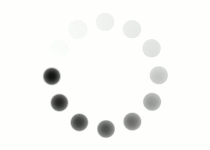Thousands of cells make up each individual T. adhaerens, and each cell falls into one of the following types: cylinder cells, cover cells, fiber cells, and gland cells. The cylinder cells and gland cells make up the ventral side of the animal. The cover cells make up the dorsal side and the fiber cells create a mesh work in between the dorsal and ventral sides. Do you remember the shape of each of those cells? When you have an answer, please click the Show Me button to see if you are correct.

Cylinder cells are cylindrically shaped and monociliated. Gland cells are rounded with numerous cilia. Cover cells are flattened near the surface and monociliated. Fiber cells are star-shaped.
View the slide show below to learn how to draw Trichoplax adhaerens.
Step 1: Draw the Dorsal Surface
Draw the dorsal (top) surface first. The cells that make up the dorsal side of the animal are the cover cells. Cover cells are flattened near the surface and each has a single cilia. Begin your drawing using the picture as a guide. Make sure to label this side the dorsal side. Also label the cell and the cilia. Step 2: Draw the Ventral Surface
Draw the ventral (bottom) surface next. Be sure to leave enough room in the middle for the last step. Cylinder cells and gland cells make up the ventral surface. The cylinder cells are shaped like cylinders and are monociliated. The gland cells have many cilia and are smaller and a bit more rounded than the cylinder cells. These two cells should be drawn alternated along the ventral surface as shown in the picture. Be sure to label the ventral surface, each cell type, and the cilia. Which of these two cells is responsible for helping digest food particles? Once you have your answer, click the Show Me button to see if you're right.
Gland cells play a big role in digestion for T. adhaerens. Step 3: Draw the Middle Meshwork
Sandwiched in between the dorsal and ventral sides is the meshwork of star-shaped fiber cells. Draw a network of these fiber cells and label them as illustrated in the picture. What is the function of the fiber cells? Once you have your answer, click the Show Me button to see if you're correct.
Fiber cells are responsible for changing the body shape of the animal, aiding in the animal's movement. |
Click the activity button below to access the Drawing Placozoa worksheet. On this worksheet, you will draw and label Trichoplax adhaerens using the directions in the slideshow on this page. When you have completed this worksheet, submit it to your teacher.



